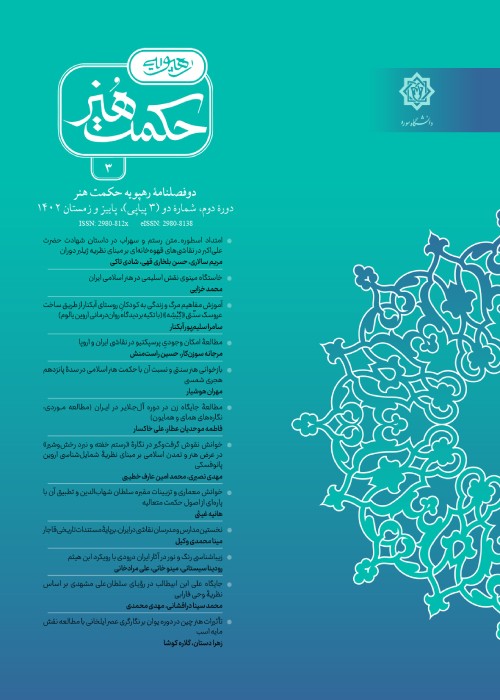The Role of Ali Ibn Abi Talib in Sultan Ali Mashhadi’s Dream Based on Farabi’s Revelation Theory
The second Iranian script of Persian calligraphy, Nastaliq, gradually emerged in the late 7th and early 8th centuries AH. For this reason, the Timurid period is considered one of the most important periods in the development of the Nastaliq script. A famous calligrapher in the Timurid era and the great master of Nastaliq script, Sultan Ali Mashhadi (1437-1520 CE), whose name is imprinted on Iranian calligraphy mentioned in his famous treatise, “Serat al-Sotour”, that he had had a great passion for calligraphy to such an extent that he had decided to fast for Ali Ibn Abi Talib, the first Imam of Shiites so that his calligraphy could reach to the highest point. After that, one night, he dreamed of Ali Ibn Abi Talib in his dream, observing his handwriting and teaching him the secrets of calligraphy. This research, based on the mentioned dream, and using a descriptive-analytical method and through documentary studies and library sources, aims to interpret the story of Sultan Ali Mashhadi’s dream by considering Hakim Abu Nasr Farabi’s Theory of Revelation to analyze the role of Ali Ibn Abi Talib in Sultan Ali Mashhadi’s dream.The founder of Islamic philosophy, Hakim Abu Nasr Farabi, was the first philosopher in the history of Islamic philosophy who methodically illuminated the issue of revelation and subsequently the prophethood mission. In his view of Revelation Theory, he explains the possibility of revelatory experience by resorting to dreams. This view has been developed and become the foundation of the great Islamic philosophers’ thoughts in the history of Islamic philosophy. To clarify the role of Ali Ibn Abi Talib in Sultan Ali Mashhadi’s dream based on Farabi’s Revelation Theory, this article first casts a glance at Farabi’s views, especially his Theory of Revelation, and then continues the research by discussing the previously mentioned dream and its intellectual basis.In the next step, the role of Ali Ibn Abi Talib is studied based on Abu Nasr Farabi’s views and his Theory of Revelation. Finally, according to the analyses and documentation represented in the last part of the study, this research shows that Ali Ibn Abi Talib not only appeared in Sultan Ali Mashhadi’s dream as the active intellect (the tenth intellect) in Farabi’s Revelation Theory but also had the same responsibility. In this role, Ali Ibn Abi Talib, as the active intellect, connects the material world with the transcendental one and provides the possibility of transferring knowledge and divine grace to the heart and soul of the calligrapher. Sultan Ali Mashhadi, who left behind his materialistic and mundane interests by fasting, made it possible to receive divine grace in his dream through the guidance of Ali Ibn Abi Talib.
- حق عضویت دریافتی صرف حمایت از نشریات عضو و نگهداری، تکمیل و توسعه مگیران میشود.
- پرداخت حق اشتراک و دانلود مقالات اجازه بازنشر آن در سایر رسانههای چاپی و دیجیتال را به کاربر نمیدهد.


